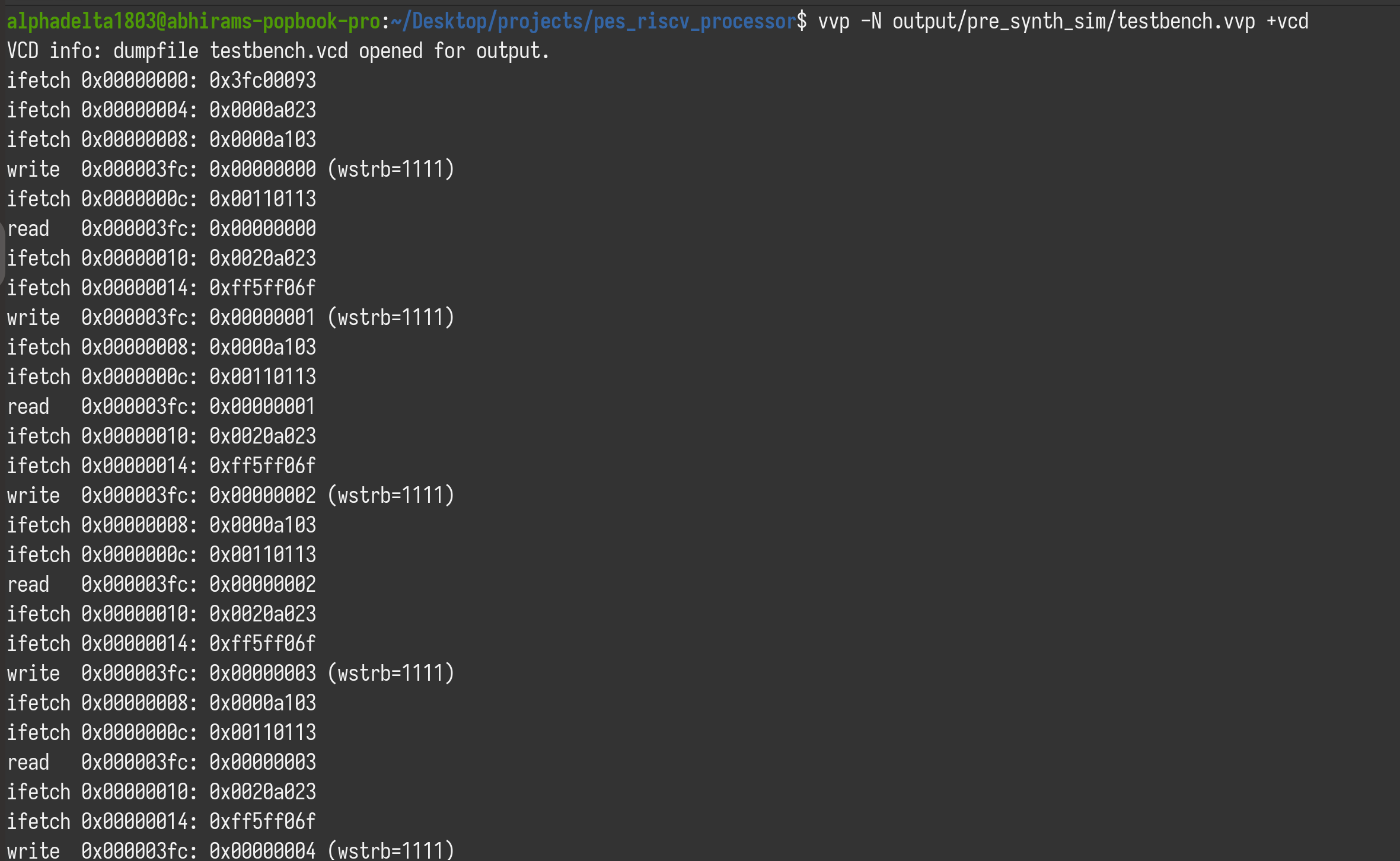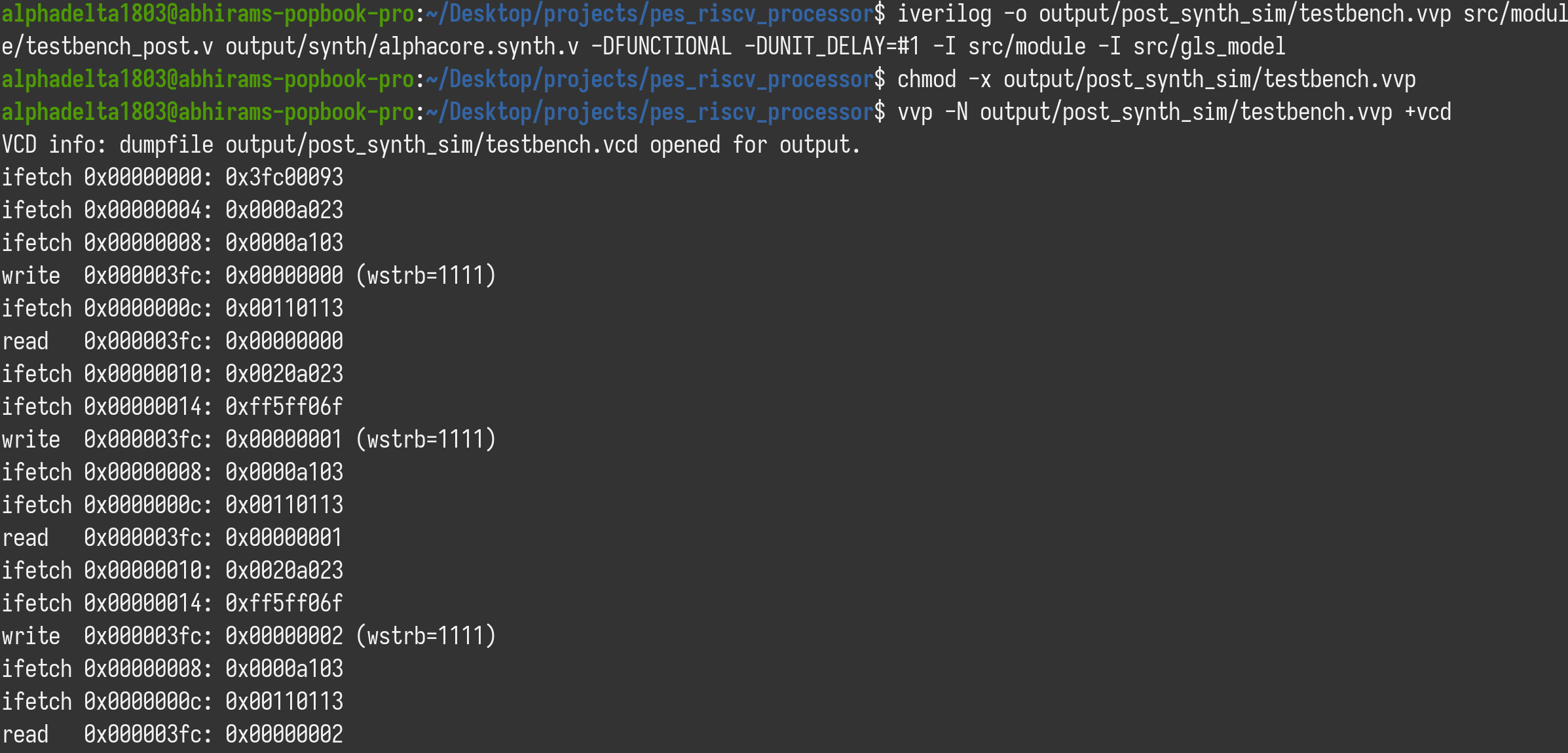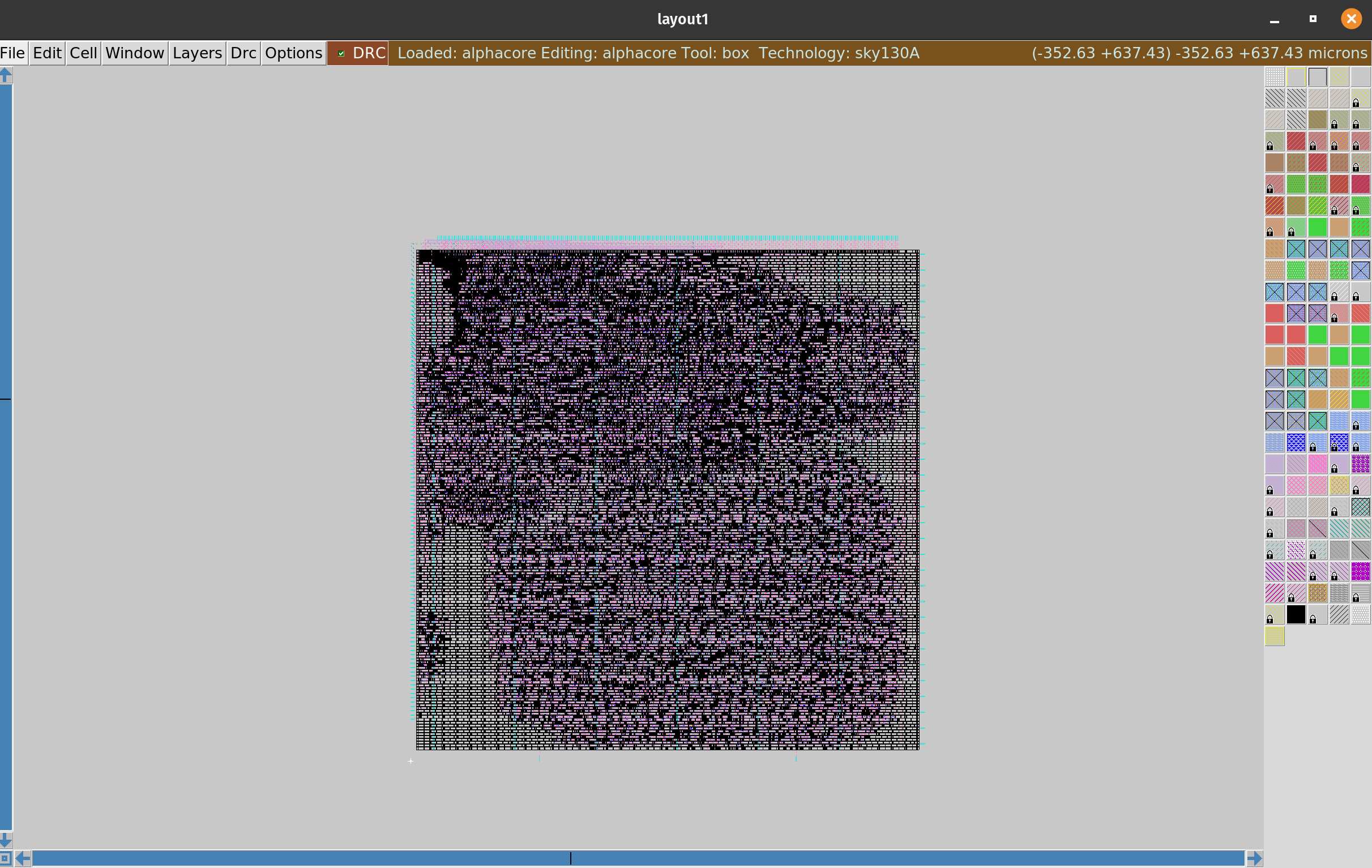- AlphaCore is a RISC-V Processor, made as a part of the VLSI Physical Design for ASICs course.
- AlphaCore is a simple RISC-V CPU, written in Verilog.
- Here, we run our testbench to ensure our RISC-V processor is running correctly
- We use
iverilogandgtkwaveto run the testbench on our module with the following command:
mkdir output/pre_synth_sim
iverilog -o output/pre_synth_sim/testbench.vvp src/module/testbench.v src/module/alphacore.v -I src/module
chmod -x output/pre_synth_sim/testbench.vvp
vvp -N output/pre_synth_sim/testbench.vvp +vcd
gtkwave output/pre_synth_sim/testbench.vcd- It gives the following output:
- In OpenLANE container, we run the following commands:
cd /home/alphadelta1803/Desktop/projects/pes_riscv_processor/src
yosys
- To synthesize our design, we execute the following commands in yosys:
read_verilog ./module/alphacore.v
read_liberty -lib ./lib/sky130_fd_sc_hd__tt_025C_1v80.lib
synth -top alphacore
dfflibmap -liberty ./lib/sky130_fd_sc_hd__tt_025C_1v80.lib
opt
abc -liberty ./lib/sky130_fd_sc_hd__tt_025C_1v80.lib -script +strash;scorr;ifraig;retime;{D};strash;dch,-f;map,-M,1,{D}
flatten
setundef -zero
clean -purge
rename -enumerate
stat
write_verilog -noattr ../output/synth/alphacore.synth.v
- After running these commands, we get a synthesized module with all of our individual components connected together in
alphacore.synth.v, found here. - These are the statistics of the design:
=== alphacore ===
Number of wires: 13024
Number of wire bits: 15103
Number of public wires: 13024
Number of public wire bits: 15103
Number of memories: 0
Number of memory bits: 0
Number of processes: 0
Number of cells: 14894
sky130_fd_sc_hd__a2111o_1 1
sky130_fd_sc_hd__a2111oi_0 6
sky130_fd_sc_hd__a211o_2 1
sky130_fd_sc_hd__a211oi_1 35
sky130_fd_sc_hd__a21boi_0 17
sky130_fd_sc_hd__a21o_2 3
sky130_fd_sc_hd__a21oi_1 2073
sky130_fd_sc_hd__a221oi_1 44
sky130_fd_sc_hd__a22o_2 3
sky130_fd_sc_hd__a22oi_1 145
sky130_fd_sc_hd__a311oi_1 10
sky130_fd_sc_hd__a31o_2 14
sky130_fd_sc_hd__a31oi_1 65
sky130_fd_sc_hd__a32o_1 5
sky130_fd_sc_hd__a32oi_1 40
sky130_fd_sc_hd__a41oi_1 4
sky130_fd_sc_hd__and2_2 6
sky130_fd_sc_hd__and3_2 2
sky130_fd_sc_hd__clkinv_1 1173
sky130_fd_sc_hd__dfxtp_1 1757
sky130_fd_sc_hd__maj3_1 1
sky130_fd_sc_hd__mux2_2 30
sky130_fd_sc_hd__mux2i_1 84
sky130_fd_sc_hd__nand2_1 3788
sky130_fd_sc_hd__nand3_1 758
sky130_fd_sc_hd__nand3b_1 6
sky130_fd_sc_hd__nand4_1 127
sky130_fd_sc_hd__nor2_1 1742
sky130_fd_sc_hd__nor3_1 143
sky130_fd_sc_hd__nor3b_1 1
sky130_fd_sc_hd__nor4_1 43
sky130_fd_sc_hd__nor4b_1 2
sky130_fd_sc_hd__o2111a_1 2
sky130_fd_sc_hd__o2111ai_1 36
sky130_fd_sc_hd__o211a_1 1
sky130_fd_sc_hd__o211ai_1 145
sky130_fd_sc_hd__o21a_1 25
sky130_fd_sc_hd__o21ai_0 1970
sky130_fd_sc_hd__o21bai_1 58
sky130_fd_sc_hd__o221a_2 2
sky130_fd_sc_hd__o221ai_1 24
sky130_fd_sc_hd__o22a_2 2
sky130_fd_sc_hd__o22ai_1 225
sky130_fd_sc_hd__o2bb2ai_1 4
sky130_fd_sc_hd__o311a_2 1
sky130_fd_sc_hd__o311ai_0 23
sky130_fd_sc_hd__o31ai_1 47
sky130_fd_sc_hd__o32ai_1 12
sky130_fd_sc_hd__o41ai_1 2
sky130_fd_sc_hd__or2_2 44
sky130_fd_sc_hd__or2b_2 65
sky130_fd_sc_hd__or3_2 7
sky130_fd_sc_hd__or3b_2 1
sky130_fd_sc_hd__or4_2 6
sky130_fd_sc_hd__xnor2_1 9
sky130_fd_sc_hd__xor2_1 54
- We use
iverilogandgtkwaveto run the testbench on our module with the following command:
iverilog -o output/post_synth_sim/testbench.vvp src/module/testbench_post.v output/synth/alphacore.synth.v -DFUNCTIONAL -DUNIT_DELAY=#1 -I src/module -I src/gls_model
chmod -x output/post_synth_sim/testbench.vvp
vvp -N output/post_synth_sim/testbench.vvp +vcd
gtkwave output/post_synth_sim/testbench.vcd- It gives the following output:
- We use OpenSTA (part of OpenLANE) to perform gate-level static timing analyser
- We verify the timing of our design using standard file formats
- After starting OpenLANE and navigating to the project directory root, we start OpenSTA using
staand run the following commands:
read_liberty -min ./lib/sky130_fd_sc_hd__tt_025C_1v80.lib
read_liberty -max ./lib/sky130_fd_sc_hd__tt_025C_1v80.lib
set_units -time ns
read_verilog ../output/synth/alphacore.synth.v
link_design alphacore
create_clock [get_ports clk] -name core_clk -period 1100
report_checks
- The results are as follows:
Startpoint: _53628_ (rising edge-triggered flip-flop clocked by core_clk)
Endpoint: _100086_ (rising edge-triggered flip-flop clocked by core_clk)
Path Group: core_clk
Path Type: max
Delay Time Description
---------------------------------------------------------
0.00 0.00 clock core_clk (rise edge)
0.00 0.00 clock network delay (ideal)
0.00 0.00 ^ _53628_/CLK (sky130_fd_sc_hd__dfxtp_1)
65.56 65.56 ^ _53628_/Q (sky130_fd_sc_hd__dfxtp_1)
957.57 1023.13 v _62832_/Y (sky130_fd_sc_hd__nor2_1)
48.57 1071.70 ^ _76642_/Y (sky130_fd_sc_hd__clkinv_1)
22.08 1093.78 v _76643_/Y (sky130_fd_sc_hd__nor2_1)
5.49 1099.27 ^ _89963_/Y (sky130_fd_sc_hd__nand3_1)
0.16 1099.43 v _89965_/Y (sky130_fd_sc_hd__o21ai_0)
0.00 1099.43 v _100086_/D (sky130_fd_sc_hd__dfxtp_1)
1099.43 data arrival time
1100.00 1100.00 clock core_clk (rise edge)
0.00 1100.00 clock network delay (ideal)
0.00 1100.00 clock reconvergence pessimism
1100.00 ^ _100086_/CLK (sky130_fd_sc_hd__dfxtp_1)
-0.25 1099.75 library setup time
1099.75 data required time
---------------------------------------------------------
1099.75 data required time
-1099.43 data arrival time
---------------------------------------------------------
0.32 slack (MET)
- Physical Design Flow is a cardinal process of converting synthesized netlist, design curtailment and standard library to a layout as per the design rules provided by the foundry.
- This layout is later sent to the foundry for the creation of the chip.
- Physical Design consists of:
- Floorplanning
- Placement
- Clock Tree Synthesis
- Optimization
- Global Routing
- We run OpenLANE in interactive mode, so that we can control the various stages
- We also use Magic in viewing and designing our circuit layout.
- We first run the following commands to set up our system and OpenLANE for layout generation:
mkdir -p output/alphacore_layout
cp -r src/designs/alphacore /usr/local/tools/OpenLane/designs- Let us examine the OpenLane settings that we use to design our processor:
set ::env(DESIGN_NAME) "alphacore"
set ::env(VERILOG_FILES) [glob $::env(DESIGN_DIR)/src/*.v]
set ::env(BASE_SDC_FILE) [glob $::env(DESIGN_DIR)/src/*.sdc]
set ::env(FP_PIN_ORDER_CFG) [glob $::env(DESIGN_DIR)/pin_order.cfg]
set ::env(CLOCK_PERIOD) "1100.00"
set ::env(CLOCK_PORT) "clk"
set ::env(CLOCK_NET) $::env(CLOCK_PORT)
set ::env(DESIGN_IS_CORE) {0}
set ::env(RUN_HEURISTIC_DIODE_INSERTION) {1}-
DESIGN_NAME: The name of the top level module of the design -
VERILOG_FILES: The path of the design's Verilog files -
BASE_SDC_FILE: Specifies the base SDC file using during the flow -
FP_PIN_ORDER_CFG: Points to the pin order configuration file to set the pins in specific directions -
CLOCK_PORT: The name of the net input to root clock buffer -
CLOCK_PERIOD: The clock period used for clocks in the design, in nanoseconds -
CLOCK_NET: The name of the net input to root clock buffer -
DESIGN_IS_CORE: Controls the layers used in the power grid, we set it to0as our design is a macro which goes inside the core. -
RUN_HEURISTIC_DIODE_INSERTION: Uses a script to place diodes more efficiently -
PL_TARGET_FREQUENCY: The desired placement density of cells, reflects how spread the cells would be on the core area, set to a high value for macros -
FP_CORE_UTIL: Core utilization percentage, set to a low value for macros -
For each macro, we create a Pin Configuration file to specify pin placement:
alphacore/pin_order.cfg
#N
trap
mem_la_read
mem_la_write
mem_la_wdata.*
mem_la_addr.*
mem_la_wstrb.*
cpi_valid
cpi_insn.*
cpi_rs1.*
cpi_rs2.*
cpi_wait
eoi.*
trace_valid
trace_data.*
#S
resetn
clk
#E
irq.*
#W
mem_valid
mem_instr
mem_ready
mem_addr.*
mem_wdata.*
mem_wstrb.*
mem_rdata.*
-
Each input/output of the module is mapped to the direction the pin should be in the final macro
-
For multiple bit wide ports, we define the mapping with
portname.*to tell the floorplanner to include all the bits of the port. -
We also create a base SDC file for each macro to instruct the Static Timing Analyser for analysis done at various stages File:
alphacore_synthesis.sdc
set_units -time ns
create_clock [get_ports clk] -name core_clk -period 1100- We then run the following command to generate the layout:
./flow.tcl -design alphacore | tee /home/alphadelta1803/pes_riscv_processor/output/alphacore_layout/alphacore.log- We then copy the result back into our main project directory:
cp -r /usr/local/tools/Openlane/designs/alphacore/runs/RUN*/logs output/alphacore_layout/logs
cp -r /usr/local/tools/Openlane/designs/alphacore/runs/RUN*/results/final output/alphacore_layout/results
cp -r /usr/local/tools/Openlane/designs/alphacore/runs/RUN*/reports output/alphacore_layout/reports- We run the following commands to see the GDSII layout of the core
magic output/macro_layout/alphacore/RUN_2023.12.03_09.03.48/results/final/mag/alphacore.mag -T src/lib/sky130A.tech- The Magic window opens up, and this is our layout for the core:








